Communication Platform Project: Non-Verbal Autistic Children's Needs
VerifiedAdded on 2023/04/24
|33
|5924
|69
Project
AI Summary
This project investigates the development of a communication platform designed for non-verbal autistic children. The project begins with extensive market research, including analysis of existing applications and interviews with specialists and therapists to identify gaps in current communication methods and understand real user-facing problems. The research informs the proposal for a new intervention, focusing on an Android mobile application and a web admin panel. The project details the conceptual design of the application, development techniques, and code development. The application aims to enhance communication and accessibility for autistic children by integrating features like digital libraries and image retrieval. The project also outlines an evaluation plan to assess the platform's usefulness and impact. The project concludes with a discussion of future work and the potential for improving the lives of individuals with autism.

Running head: TECHNOLOGY FOR NON-VERBAL AUTISTIC CHILDREN
COMMUNICATION PLATFORM FOR NON-VERBAL AUTISTIC CHILDREN
Name of the Student
Name of the University
Author note
COMMUNICATION PLATFORM FOR NON-VERBAL AUTISTIC CHILDREN
Name of the Student
Name of the University
Author note
Paraphrase This Document
Need a fresh take? Get an instant paraphrase of this document with our AI Paraphraser
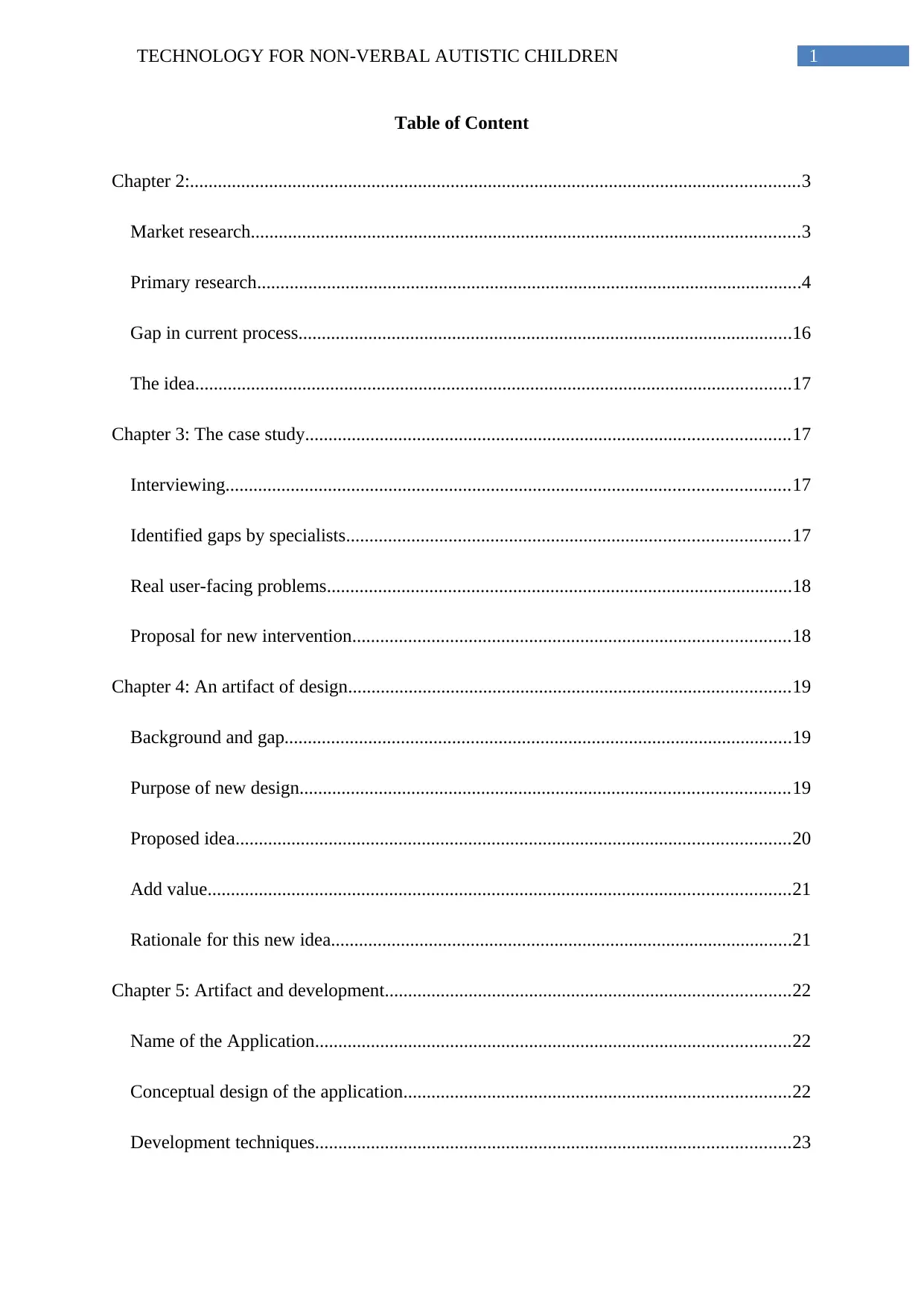
1TECHNOLOGY FOR NON-VERBAL AUTISTIC CHILDREN
Table of Content
Chapter 2:...................................................................................................................................3
Market research......................................................................................................................3
Primary research.....................................................................................................................4
Gap in current process..........................................................................................................16
The idea................................................................................................................................17
Chapter 3: The case study........................................................................................................17
Interviewing.........................................................................................................................17
Identified gaps by specialists...............................................................................................17
Real user-facing problems....................................................................................................18
Proposal for new intervention..............................................................................................18
Chapter 4: An artifact of design...............................................................................................19
Background and gap.............................................................................................................19
Purpose of new design.........................................................................................................19
Proposed idea.......................................................................................................................20
Add value.............................................................................................................................21
Rationale for this new idea...................................................................................................21
Chapter 5: Artifact and development.......................................................................................22
Name of the Application......................................................................................................22
Conceptual design of the application...................................................................................22
Development techniques......................................................................................................23
Table of Content
Chapter 2:...................................................................................................................................3
Market research......................................................................................................................3
Primary research.....................................................................................................................4
Gap in current process..........................................................................................................16
The idea................................................................................................................................17
Chapter 3: The case study........................................................................................................17
Interviewing.........................................................................................................................17
Identified gaps by specialists...............................................................................................17
Real user-facing problems....................................................................................................18
Proposal for new intervention..............................................................................................18
Chapter 4: An artifact of design...............................................................................................19
Background and gap.............................................................................................................19
Purpose of new design.........................................................................................................19
Proposed idea.......................................................................................................................20
Add value.............................................................................................................................21
Rationale for this new idea...................................................................................................21
Chapter 5: Artifact and development.......................................................................................22
Name of the Application......................................................................................................22
Conceptual design of the application...................................................................................22
Development techniques......................................................................................................23
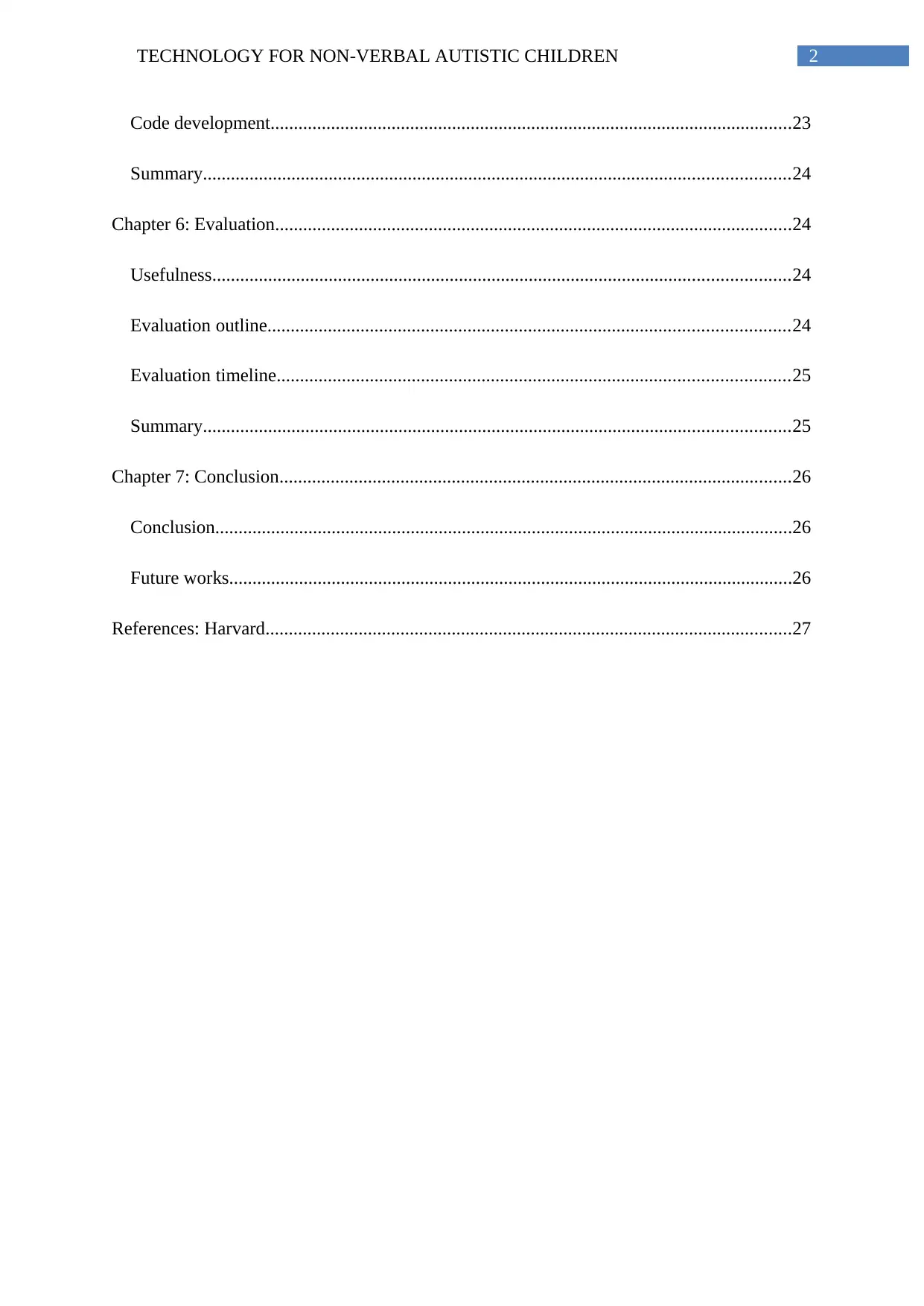
2TECHNOLOGY FOR NON-VERBAL AUTISTIC CHILDREN
Code development................................................................................................................23
Summary..............................................................................................................................24
Chapter 6: Evaluation...............................................................................................................24
Usefulness............................................................................................................................24
Evaluation outline................................................................................................................24
Evaluation timeline..............................................................................................................25
Summary..............................................................................................................................25
Chapter 7: Conclusion..............................................................................................................26
Conclusion............................................................................................................................26
Future works.........................................................................................................................26
References: Harvard.................................................................................................................27
Code development................................................................................................................23
Summary..............................................................................................................................24
Chapter 6: Evaluation...............................................................................................................24
Usefulness............................................................................................................................24
Evaluation outline................................................................................................................24
Evaluation timeline..............................................................................................................25
Summary..............................................................................................................................25
Chapter 7: Conclusion..............................................................................................................26
Conclusion............................................................................................................................26
Future works.........................................................................................................................26
References: Harvard.................................................................................................................27
⊘ This is a preview!⊘
Do you want full access?
Subscribe today to unlock all pages.

Trusted by 1+ million students worldwide

3TECHNOLOGY FOR NON-VERBAL AUTISTIC CHILDREN
Chapter 2:
Market research
The recent years have seen the prevalence of Autism Spectrum
Disorder(ASD) increase at unprecedented rate. So far, the development
condition is listed among the major cases of mental disorders in various
parts of the worlds including the UK, US, and India. Note that the
incidence rate in the mentioned regions are 1 in 64, 1 in 68, and 1 in 150
respectively (Kuriakose & Lahiri 2017). The lifelong condition is usually
evidenced in the children under the age of 3, and it curtails their ability to
communicate normally, from social relationship, and engage in normal
behaviour. The modern world is characterized by sophisticated level of
Information and Communication Technology(ICT) advancement that
appear instrumental in the alleviation of most of the communication and
socialization challenges faced by autistic children. As far as autism
concerned, major process has been made in the fields of Information
Technology and robotics (Teevan, Dumais, & Horvitz 2017). A range of
computer, smartphone, and artificial intelligence (merged with robotics)
software have been developed to help this population cope with their
communication and socialization needs (Golestan, Soleiman, & Moradi
2017). By now, it is apparent that different interventions have emerged in
attempt to improve the lives of people spectrum from autism. Some of the
common applications include Pocket PC Picture Exchange Communication
System (PECS), Let’s Talk Voice Output Communications Aid (VOCA),
dmTEA, and AUTHIC. Note that the first two focus on developing the
Chapter 2:
Market research
The recent years have seen the prevalence of Autism Spectrum
Disorder(ASD) increase at unprecedented rate. So far, the development
condition is listed among the major cases of mental disorders in various
parts of the worlds including the UK, US, and India. Note that the
incidence rate in the mentioned regions are 1 in 64, 1 in 68, and 1 in 150
respectively (Kuriakose & Lahiri 2017). The lifelong condition is usually
evidenced in the children under the age of 3, and it curtails their ability to
communicate normally, from social relationship, and engage in normal
behaviour. The modern world is characterized by sophisticated level of
Information and Communication Technology(ICT) advancement that
appear instrumental in the alleviation of most of the communication and
socialization challenges faced by autistic children. As far as autism
concerned, major process has been made in the fields of Information
Technology and robotics (Teevan, Dumais, & Horvitz 2017). A range of
computer, smartphone, and artificial intelligence (merged with robotics)
software have been developed to help this population cope with their
communication and socialization needs (Golestan, Soleiman, & Moradi
2017). By now, it is apparent that different interventions have emerged in
attempt to improve the lives of people spectrum from autism. Some of the
common applications include Pocket PC Picture Exchange Communication
System (PECS), Let’s Talk Voice Output Communications Aid (VOCA),
dmTEA, and AUTHIC. Note that the first two focus on developing the
Paraphrase This Document
Need a fresh take? Get an instant paraphrase of this document with our AI Paraphraser
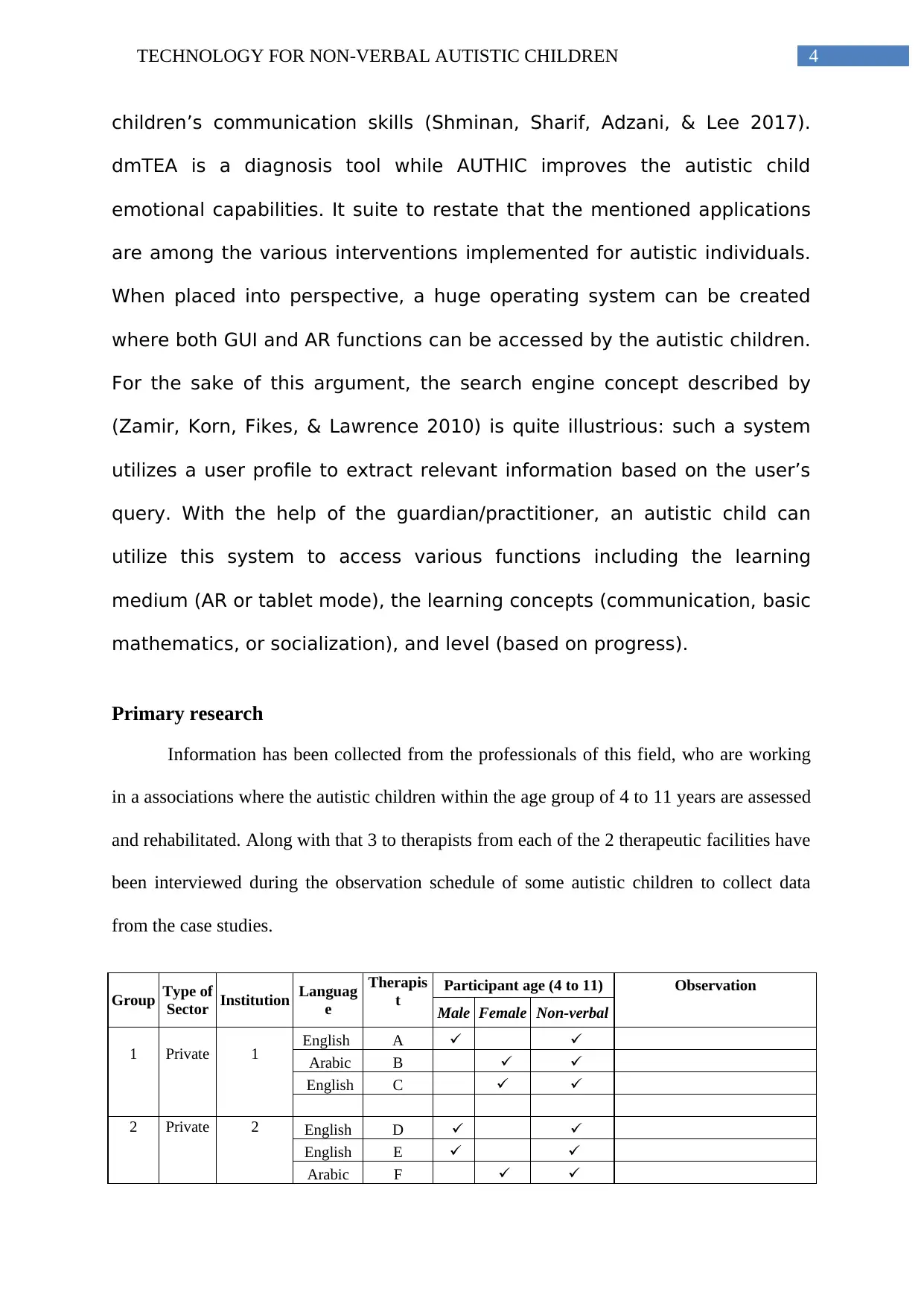
4TECHNOLOGY FOR NON-VERBAL AUTISTIC CHILDREN
children’s communication skills (Shminan, Sharif, Adzani, & Lee 2017).
dmTEA is a diagnosis tool while AUTHIC improves the autistic child
emotional capabilities. It suite to restate that the mentioned applications
are among the various interventions implemented for autistic individuals.
When placed into perspective, a huge operating system can be created
where both GUI and AR functions can be accessed by the autistic children.
For the sake of this argument, the search engine concept described by
(Zamir, Korn, Fikes, & Lawrence 2010) is quite illustrious: such a system
utilizes a user profile to extract relevant information based on the user’s
query. With the help of the guardian/practitioner, an autistic child can
utilize this system to access various functions including the learning
medium (AR or tablet mode), the learning concepts (communication, basic
mathematics, or socialization), and level (based on progress).
Primary research
Information has been collected from the professionals of this field, who are working
in a associations where the autistic children within the age group of 4 to 11 years are assessed
and rehabilitated. Along with that 3 to therapists from each of the 2 therapeutic facilities have
been interviewed during the observation schedule of some autistic children to collect data
from the case studies.
Group Type of
Sector Institution Languag
e
Therapis
t Participant age (4 to 11) Observation
Male Female Non-verbal
1 Private 1 English A
Arabic B
English C
2 Private 2 English D
English E
Arabic F
children’s communication skills (Shminan, Sharif, Adzani, & Lee 2017).
dmTEA is a diagnosis tool while AUTHIC improves the autistic child
emotional capabilities. It suite to restate that the mentioned applications
are among the various interventions implemented for autistic individuals.
When placed into perspective, a huge operating system can be created
where both GUI and AR functions can be accessed by the autistic children.
For the sake of this argument, the search engine concept described by
(Zamir, Korn, Fikes, & Lawrence 2010) is quite illustrious: such a system
utilizes a user profile to extract relevant information based on the user’s
query. With the help of the guardian/practitioner, an autistic child can
utilize this system to access various functions including the learning
medium (AR or tablet mode), the learning concepts (communication, basic
mathematics, or socialization), and level (based on progress).
Primary research
Information has been collected from the professionals of this field, who are working
in a associations where the autistic children within the age group of 4 to 11 years are assessed
and rehabilitated. Along with that 3 to therapists from each of the 2 therapeutic facilities have
been interviewed during the observation schedule of some autistic children to collect data
from the case studies.
Group Type of
Sector Institution Languag
e
Therapis
t Participant age (4 to 11) Observation
Male Female Non-verbal
1 Private 1 English A
Arabic B
English C
2 Private 2 English D
English E
Arabic F

5TECHNOLOGY FOR NON-VERBAL AUTISTIC CHILDREN
All the result has been collected using google form in both languages (English and the
Arabic) (Google Docs, 2019).
Primary data regarding demographics
Age
25
26 - 30
31 - 35
36 - 40
41 - 45
45 - 50
46 - 50
46- 50
51 - 55
51 and more
Figure 2 Answering by Age (Google Docs 2019)
From the primary data collection regarding age of the participants, it can be clearly visible
that most of the participants are 31 to 35 years old, where the number of parturient from 36 to
50 is also high. Considering all these percentage distributions, it has been found that most of
the participants are from 31 to 50 years old.
All the result has been collected using google form in both languages (English and the
Arabic) (Google Docs, 2019).
Primary data regarding demographics
Age
25
26 - 30
31 - 35
36 - 40
41 - 45
45 - 50
46 - 50
46- 50
51 - 55
51 and more
Figure 2 Answering by Age (Google Docs 2019)
From the primary data collection regarding age of the participants, it can be clearly visible
that most of the participants are 31 to 35 years old, where the number of parturient from 36 to
50 is also high. Considering all these percentage distributions, it has been found that most of
the participants are from 31 to 50 years old.
⊘ This is a preview!⊘
Do you want full access?
Subscribe today to unlock all pages.

Trusted by 1+ million students worldwide
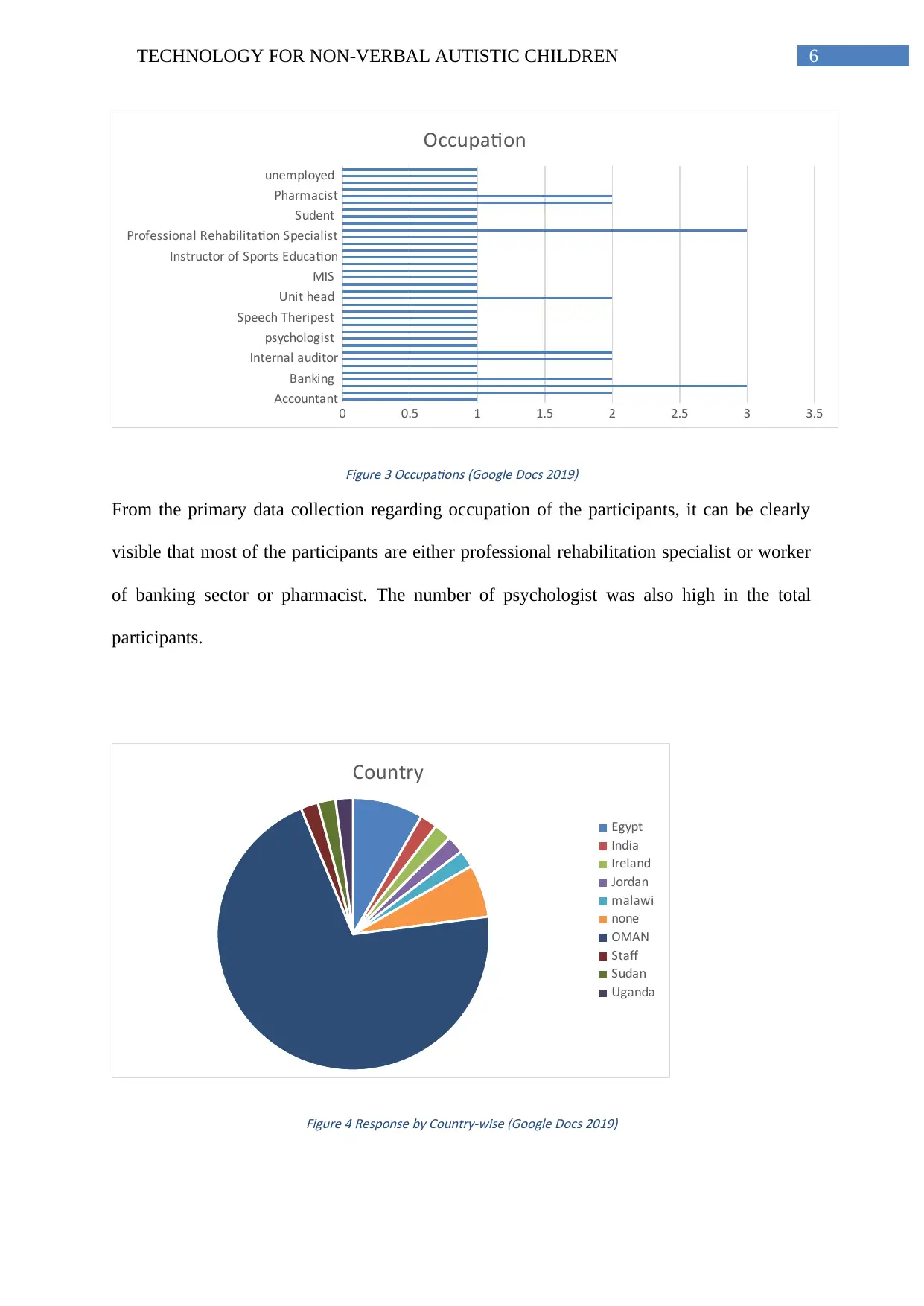
6TECHNOLOGY FOR NON-VERBAL AUTISTIC CHILDREN
Accountant
Banking
Internal auditor
psychologist
Speech Theripest
Unit head
MIS
Instructor of Sports Education
Professional Rehabilitation Specialist
Sudent
Pharmacist
unemployed
0 0.5 1 1.5 2 2.5 3 3.5
Occupation
Figure 3 Occupations (Google Docs 2019)
From the primary data collection regarding occupation of the participants, it can be clearly
visible that most of the participants are either professional rehabilitation specialist or worker
of banking sector or pharmacist. The number of psychologist was also high in the total
participants.
Country
Egypt
India
Ireland
Jordan
malawi
none
OMAN
Staff
Sudan
Uganda
Figure 4 Response by Country-wise (Google Docs 2019)
Accountant
Banking
Internal auditor
psychologist
Speech Theripest
Unit head
MIS
Instructor of Sports Education
Professional Rehabilitation Specialist
Sudent
Pharmacist
unemployed
0 0.5 1 1.5 2 2.5 3 3.5
Occupation
Figure 3 Occupations (Google Docs 2019)
From the primary data collection regarding occupation of the participants, it can be clearly
visible that most of the participants are either professional rehabilitation specialist or worker
of banking sector or pharmacist. The number of psychologist was also high in the total
participants.
Country
Egypt
India
Ireland
Jordan
malawi
none
OMAN
Staff
Sudan
Uganda
Figure 4 Response by Country-wise (Google Docs 2019)
Paraphrase This Document
Need a fresh take? Get an instant paraphrase of this document with our AI Paraphraser
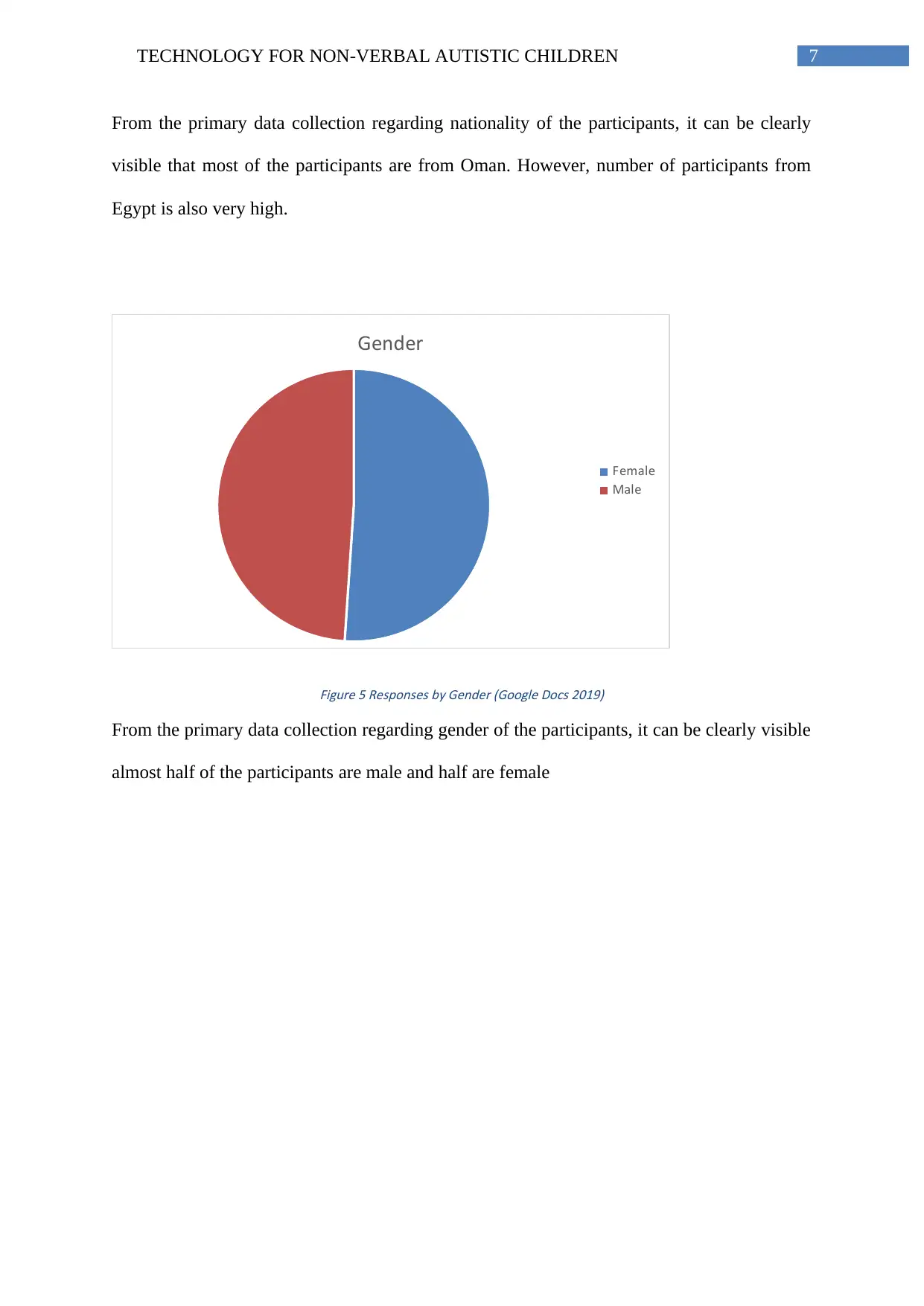
7TECHNOLOGY FOR NON-VERBAL AUTISTIC CHILDREN
From the primary data collection regarding nationality of the participants, it can be clearly
visible that most of the participants are from Oman. However, number of participants from
Egypt is also very high.
Gender
Female
Male
Figure 5 Responses by Gender (Google Docs 2019)
From the primary data collection regarding gender of the participants, it can be clearly visible
almost half of the participants are male and half are female
From the primary data collection regarding nationality of the participants, it can be clearly
visible that most of the participants are from Oman. However, number of participants from
Egypt is also very high.
Gender
Female
Male
Figure 5 Responses by Gender (Google Docs 2019)
From the primary data collection regarding gender of the participants, it can be clearly visible
almost half of the participants are male and half are female
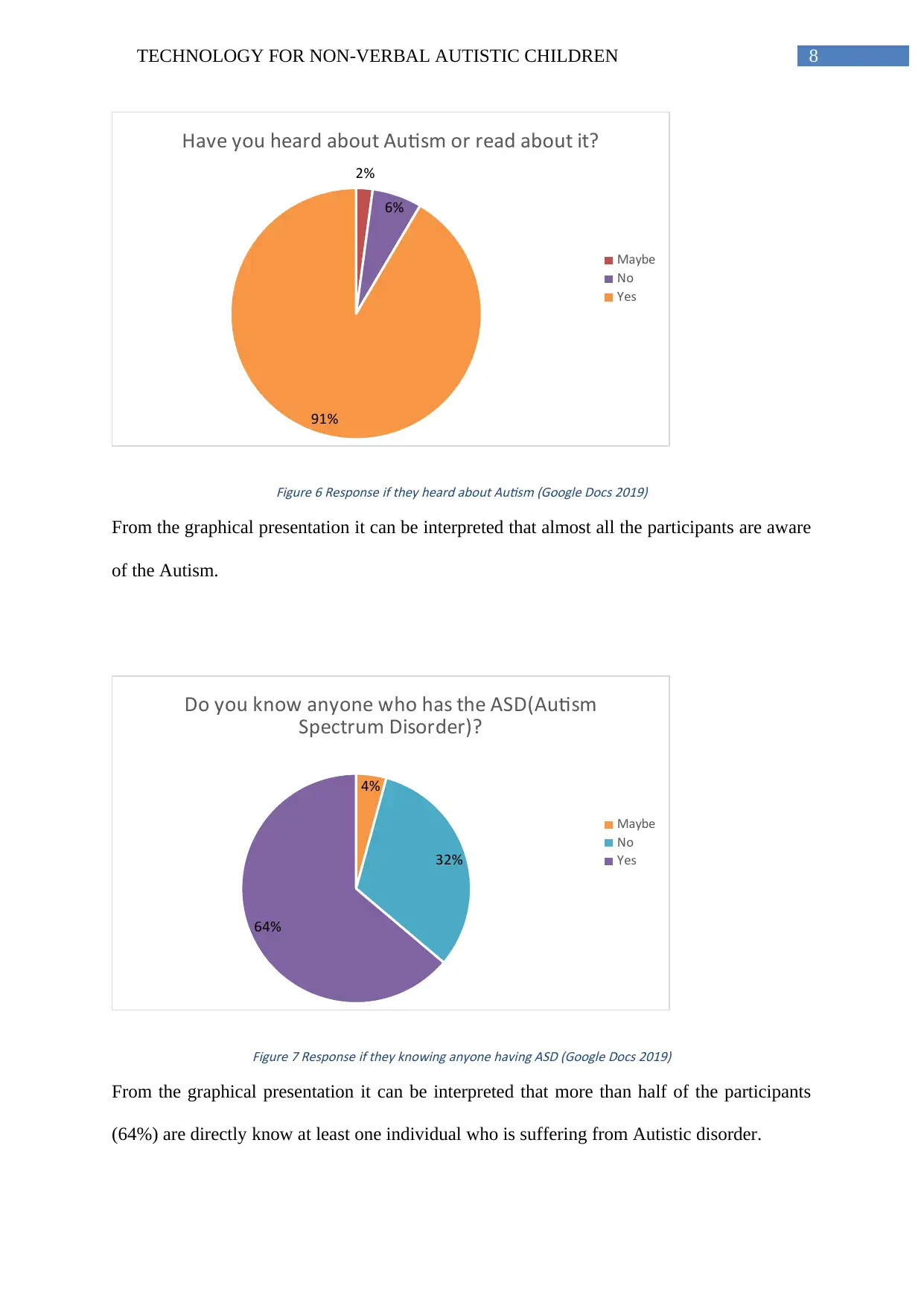
8TECHNOLOGY FOR NON-VERBAL AUTISTIC CHILDREN
2%
6%
91%
Have you heard about Autism or read about it?
Maybe
No
Yes
Figure 6 Response if they heard about Autism (Google Docs 2019)
From the graphical presentation it can be interpreted that almost all the participants are aware
of the Autism.
4%
32%
64%
Do you know anyone who has the ASD(Autism
Spectrum Disorder)?
Maybe
No
Yes
Figure 7 Response if they knowing anyone having ASD (Google Docs 2019)
From the graphical presentation it can be interpreted that more than half of the participants
(64%) are directly know at least one individual who is suffering from Autistic disorder.
2%
6%
91%
Have you heard about Autism or read about it?
Maybe
No
Yes
Figure 6 Response if they heard about Autism (Google Docs 2019)
From the graphical presentation it can be interpreted that almost all the participants are aware
of the Autism.
4%
32%
64%
Do you know anyone who has the ASD(Autism
Spectrum Disorder)?
Maybe
No
Yes
Figure 7 Response if they knowing anyone having ASD (Google Docs 2019)
From the graphical presentation it can be interpreted that more than half of the participants
(64%) are directly know at least one individual who is suffering from Autistic disorder.
⊘ This is a preview!⊘
Do you want full access?
Subscribe today to unlock all pages.

Trusted by 1+ million students worldwide
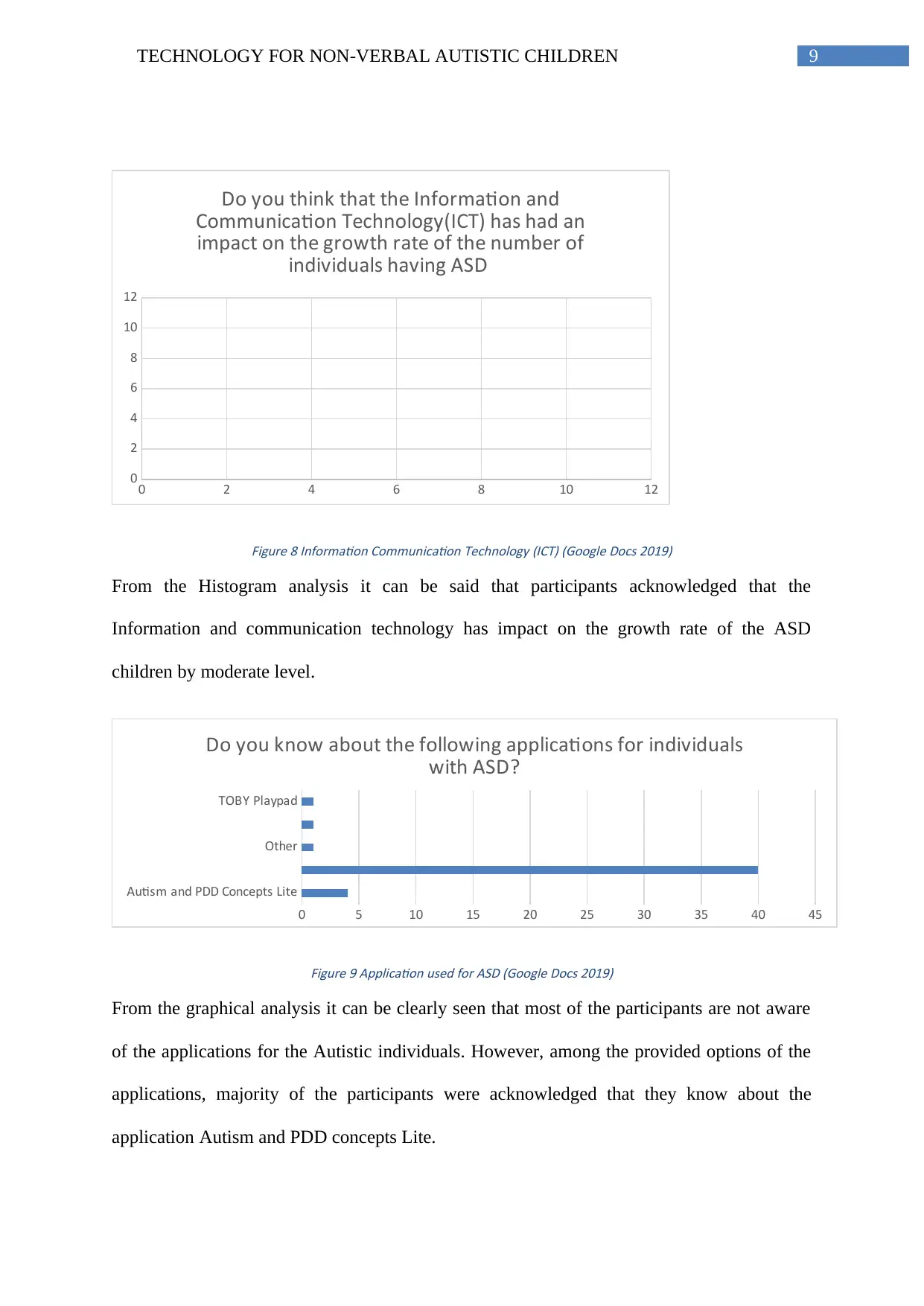
9TECHNOLOGY FOR NON-VERBAL AUTISTIC CHILDREN
0 2 4 6 8 10 12
0
2
4
6
8
10
12
Do you think that the Information and
Communication Technology(ICT) has had an
impact on the growth rate of the number of
individuals having ASD
Figure 8 Information Communication Technology (ICT) (Google Docs 2019)
From the Histogram analysis it can be said that participants acknowledged that the
Information and communication technology has impact on the growth rate of the ASD
children by moderate level.
Autism and PDD Concepts Lite
Other
TOBY Playpad
0 5 10 15 20 25 30 35 40 45
Do you know about the following applications for individuals
with ASD?
Figure 9 Application used for ASD (Google Docs 2019)
From the graphical analysis it can be clearly seen that most of the participants are not aware
of the applications for the Autistic individuals. However, among the provided options of the
applications, majority of the participants were acknowledged that they know about the
application Autism and PDD concepts Lite.
0 2 4 6 8 10 12
0
2
4
6
8
10
12
Do you think that the Information and
Communication Technology(ICT) has had an
impact on the growth rate of the number of
individuals having ASD
Figure 8 Information Communication Technology (ICT) (Google Docs 2019)
From the Histogram analysis it can be said that participants acknowledged that the
Information and communication technology has impact on the growth rate of the ASD
children by moderate level.
Autism and PDD Concepts Lite
Other
TOBY Playpad
0 5 10 15 20 25 30 35 40 45
Do you know about the following applications for individuals
with ASD?
Figure 9 Application used for ASD (Google Docs 2019)
From the graphical analysis it can be clearly seen that most of the participants are not aware
of the applications for the Autistic individuals. However, among the provided options of the
applications, majority of the participants were acknowledged that they know about the
application Autism and PDD concepts Lite.
Paraphrase This Document
Need a fresh take? Get an instant paraphrase of this document with our AI Paraphraser

10TECHNOLOGY FOR NON-VERBAL AUTISTIC CHILDREN
53%
4%
43%
Do you think that the digital applications help in
combating against mental disorders like ASDs
Maybe
No
Yes
Figure 1 Response of using Digital Application (Google Docs 2019)
More than half of the total respondents were not sure about the effectiveness of digital
application to combat against mental disorder like ASD. However, among the rest of the
participants, majority supported that the digital application can help to combat mental
disorders like ASD.
53%
4%
43%
Do you think that the digital applications help in
combating against mental disorders like ASDs
Maybe
No
Yes
Figure 1 Response of using Digital Application (Google Docs 2019)
More than half of the total respondents were not sure about the effectiveness of digital
application to combat against mental disorder like ASD. However, among the rest of the
participants, majority supported that the digital application can help to combat mental
disorders like ASD.
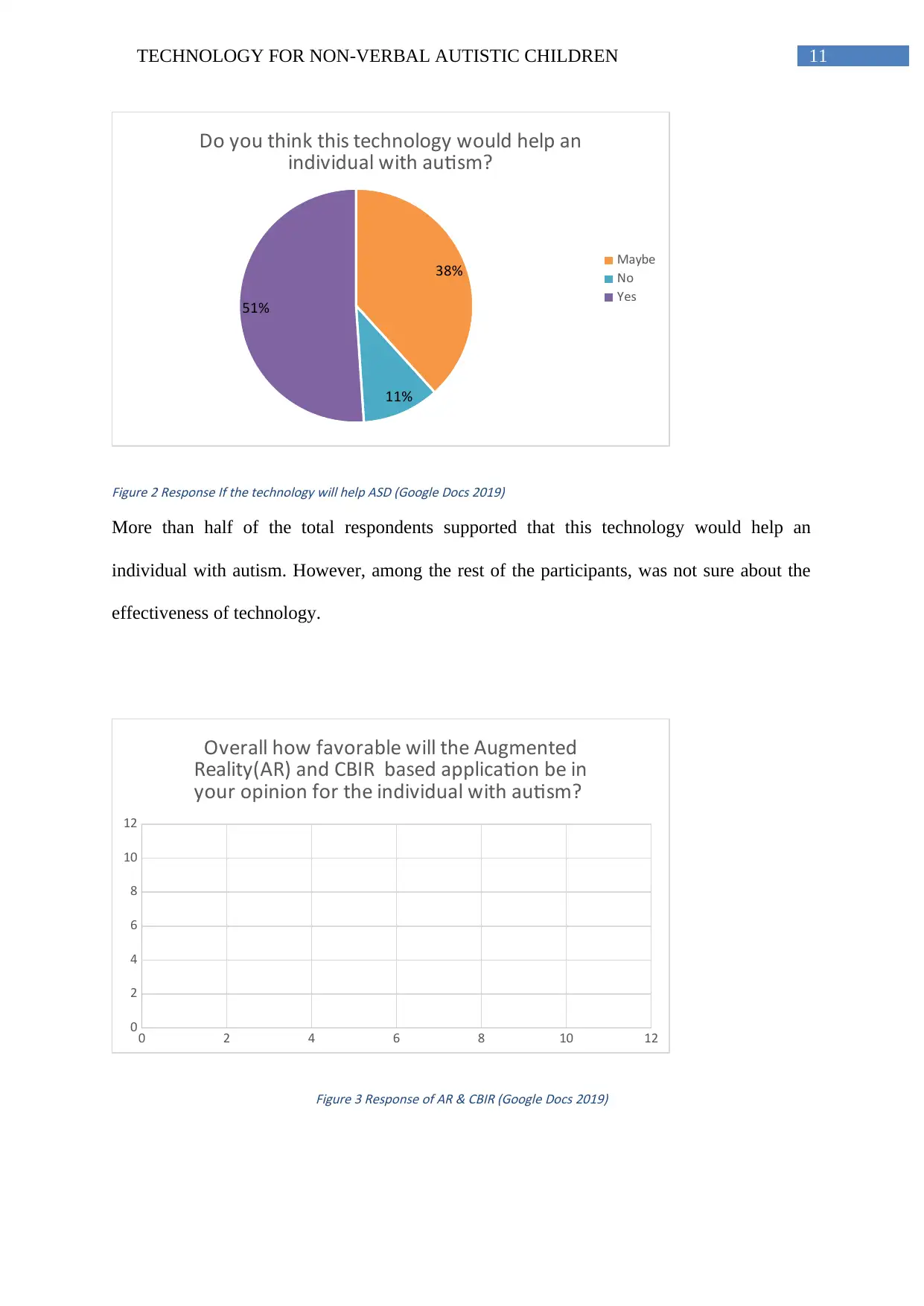
11TECHNOLOGY FOR NON-VERBAL AUTISTIC CHILDREN
38%
11%
51%
Do you think this technology would help an
individual with autism?
Maybe
No
Yes
Figure 2 Response If the technology will help ASD (Google Docs 2019)
More than half of the total respondents supported that this technology would help an
individual with autism. However, among the rest of the participants, was not sure about the
effectiveness of technology.
0 2 4 6 8 10 12
0
2
4
6
8
10
12
Overall how favorable will the Augmented
Reality(AR) and CBIR based application be in
your opinion for the individual with autism?
Figure 3 Response of AR & CBIR (Google Docs 2019)
38%
11%
51%
Do you think this technology would help an
individual with autism?
Maybe
No
Yes
Figure 2 Response If the technology will help ASD (Google Docs 2019)
More than half of the total respondents supported that this technology would help an
individual with autism. However, among the rest of the participants, was not sure about the
effectiveness of technology.
0 2 4 6 8 10 12
0
2
4
6
8
10
12
Overall how favorable will the Augmented
Reality(AR) and CBIR based application be in
your opinion for the individual with autism?
Figure 3 Response of AR & CBIR (Google Docs 2019)
⊘ This is a preview!⊘
Do you want full access?
Subscribe today to unlock all pages.

Trusted by 1+ million students worldwide
1 out of 33
Related Documents
Your All-in-One AI-Powered Toolkit for Academic Success.
+13062052269
info@desklib.com
Available 24*7 on WhatsApp / Email
![[object Object]](/_next/static/media/star-bottom.7253800d.svg)
Unlock your academic potential
Copyright © 2020–2025 A2Z Services. All Rights Reserved. Developed and managed by ZUCOL.





